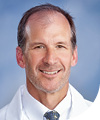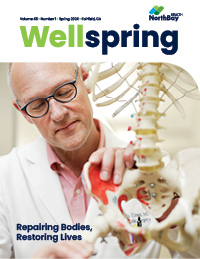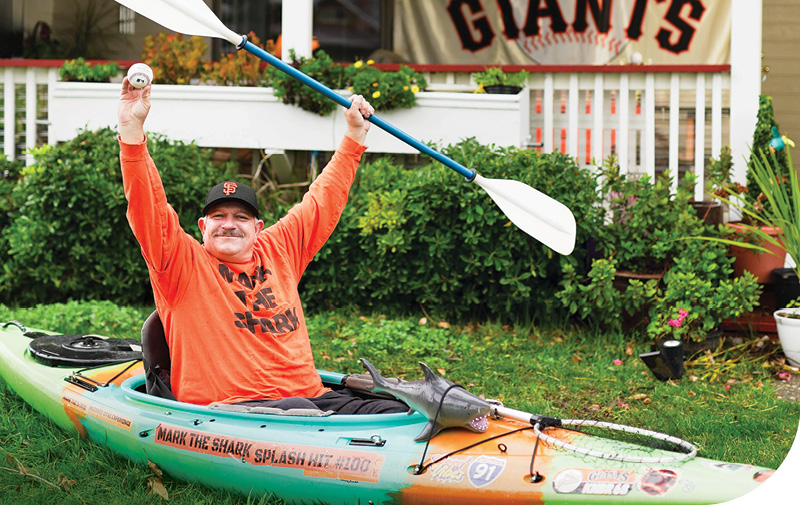
‘Mark the Shark’ is Back in Business
New Knees Make all the Difference for McCovey Cove Ball Hawk.
Vacaville resident Mark Gerek is known by another name to the fans who float in McCovey Cove just outside the San Francisco Giant’s baseball stadium.
They call him “Mark the Shark” because he likes to float in his kayak while waiting for the next homerun ball to splash into the water, so he and a host of other “ball hawks” can chase after it. He garnered some fame last June when he was able to retrieve the 100th homerun “splash hit” ball at the park — an achievement captured live on television for the world to see.
What the world wasn’t seeing was the extreme knee pain it caused him to carry his kayak and to get in and out of it during each visit to McCovey Cove.
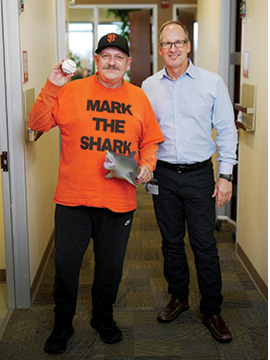
“I have always been an active guy. I’ve ridden my bike from Sacramento to San Francisco six times over the years,” he said. “And I was a very active child. Riding bikes, jumping off roofs, skiing; I was just always going.”
As an adult, he worked as a water-proofer in a union job in San Francisco for many years — a job he says had him “dangling from buildings to caulk windows and so forth.”
That active lifestyle came at a price: osteoarthritis.
Osteoarthritis is the most common type of arthritis, affecting more than 32.5 million adults in the United States, according to the Centers for Disease Control and Prevention. It occurs when the protective cartilage that cushions the ends of the bones wears down over time.
Osteoarthritis can degrade cartilage, change bone shape and cause inflammation, resulting in pain, stiffness and loss of mobility.
So Mark turned to NorthBay Health in search of help.
Through the years he tried over-the-counter pain relief but otherwise just tried to “tough it out,” he said. Having gone through a hip replacement years before, he knew that knee replacement surgery was likely.
“The arthritis is the cause of it all, both knees were down to bone-on-bone,” he said. “I was always so active. It wasn’t about an injury or anything like that. It’s just life.”
Diagnosis and Treatment
Mark was referred to NorthBay Health Orthopedic surgeon Andrew Brooks, M.D., medical director of NorthBay’s Joint Replacement Program.
“The decision to proceed with a knee or hip replacement is based on a lot of factors. We look at the history and complaints and exactly how the arthritis is interfering with quality of life,” said Dr. Brooks. “We do a physical exam and look at various diagnostic tests such as X-rays and MRIs. We look at how the arthritis has progressed over the years and what treatments the patient has tried.”
“A patient’s frame of mind plays a role in resilience and their ability to bounce back after surgery.”
Andrew Brooks, M.D., Orthopedic Surgeon
Dr. Brooks looks at the health of each patient as well. “If non-surgical treatment has been ineffective we discuss pros and cons of joint replacement,” he explained. “It is certainly a decision that requires careful consideration and we want each patient to be properly educated on risks and expected recovery. Ultimately, it is a decision that is made in collaboration between the patient and surgeon. It’s not something you go into lightly but in Mark’s case, he was not the kind of guy to just sit around. He was active, highly motivated, optimistic and with a clear goal — to be able to carry his kayak and get in and out of it without the pain.”
That positive mindset and clear goal is important, Dr. Brooks noted.
“A patient’s frame of mind plays a role in resilience and their ability to bounce back after surgery,” he said. “Understanding his goal and that it was a realistic goal was important, too. We aren’t restoring a knee to what it was when you were 18 years old, but it is possible for it to be in better shape and be more active than before the surgery, so Mark’s goal was a reasonable one.”
Getting an Education
Still, there is plenty of education required for joint replacement patients, even one as motivated as Mark.
The NorthBay Health Joint Replacement Program includes individualized education sessions before and after surgery to help patients understand what to expect from their surgery and how to prepare for recovery.
A patient education handbook is provided in the clinic and patients are enrolled in the GetWell Network once they are scheduled for surgery. The GetWell Network is an interactive education platform with videos that also allow patients to send messages to their doctors up to two weeks after surgery.
It’s mandatory that all NorthBay patients attend a Pre-op Education class two weeks prior to their surgeries.

“In the class, I discuss the intraoperative process (from preparation to discharge) and what to expect during their hospital stay until recovery at home,” said Loida de Vera, Joint Replacement Program Coordinator. “During the class, they will also meet some of our interdisciplinary team members from Rehabilitation Services, dietary and case management departments. Each member discusses their roles and educates our patients.” The session also includes discussions on safety, pain management, precautions/ restrictions and post-op complications prevention.
Handouts are shared and a nurse goes over instructions for patients to follow after their surgery.
“We also give patients the chance to ask questions and ensure they know how to contact us for any concerns,” Loida explained. The goal is simple, she said: “To ensure success and patient satisfaction.”
In Mark’s case, he needed both knees replaced and one of his first questions was about how that would be handled.
“I asked Dr. Brooks if we could do them both at once, but he said ‘absolutely not,’” Mark recalled.
Dr. Brooks noted that it’s not unusual for a patient who had one knee replacement to have the second knee done, but that studies have shown more risk of complications if both are done at the same time. So usually there are several weeks, minimum, between the surgeries.
Mark had his left knee replacement in August 2023, a couple of months after getting the 100th Splash Ball. Nine weeks later, in October 2023, he had his right knee done.
Recovery After Surgery
Rehabilitating following surgery is not for the faint of heart, said Mark.
He would know, as he had a hip replacement many years ago. He admits knees are a tougher rehab, but he praised his physical therapy team at NorthBay for making “the whole process so easy and smooth.”
He also admits that he was very much committed to the rehabilitation process.
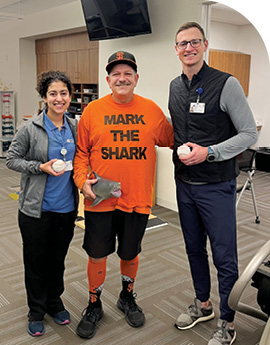
“I’m an eager beaver,” he joked. “There was no way that I wouldn’t cooperate with physical therapy. I know that if you don’t do it, you have more problems, so I was going to make sure I got it done.”
That kind of attitude is what makes physical therapists very happy, said Mark Rivera, Rehabilitation Supervisor.
“Physical therapy is essential to the progress. It is absolutely necessary,” he said. “There is a lot of education involved in addition to the exercise and movement we help them with. We are also educating them on the healing process and what to expect, and we give a lot of pep talks to keep the patient going.”
Mark’s physical therapist, Tyler Berg, noted that having his two surgeries nine weeks apart actually provided an opportunity for Mark to not only recover from the first surgery but to be better prepared for recovering from the second one.
“Because he worked on recovery from the first knee, he was already in a situation where the exercises were built into his daily routine,” he said. “And that makes the recovery after the second surgery go smoother.”
With knee replacements, Tyler said, the primary focus in therapy is to first work on restoring the patient’s ability to do daily tasks and basic things like getting up and out of a chair, up and down stairs. “So we do a lot of strengthening and work on range of motion, where bending the knee is a focus,” he said. “We also worked on his ability to straighten the knee, so that he would have a proper gait as he walked.”
Mark’s long-term goal played a key role in how his therapy was designed.
“Our primary end goal was making sure he would be comfortable getting in and out of his kayak as efficiently as possible for him,” Tyler explained.
Mark’s dedication to doing his exercises at home as well as during his physical therapy sessions was key, Tyler said.
“I always tell people that rehab happens outside of our sessions,” he said. “They are doing the work and we are here to guide them and get them on the right track.”
Mark agrees, and has advice for others who consider the surgery.
“Be positive,” he said. “The reason they do a knee replacement is to make people feel better. It’s not easy, but the rehab works.”
Back on the Water
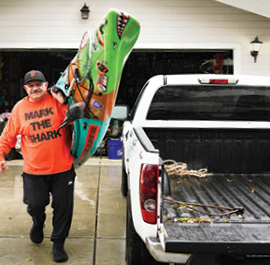 Following several weeks of physical therapy after his second knee surgery, Mark is back in the game, and loving it.
Following several weeks of physical therapy after his second knee surgery, Mark is back in the game, and loving it.
While topping the once-in-a-lifetime 100th Splash Hit Ball may be tough (he gave the ball back to the player in exchange for signed balls, a bat, photos and memorabilia), Mark said he headed back to McCovey Cove with his kayak “as soon as Dr. Brooks cleared me!”
On his Instagram he summed it up simply: “Mark is rebuilt and I’m going to the Cove!”
